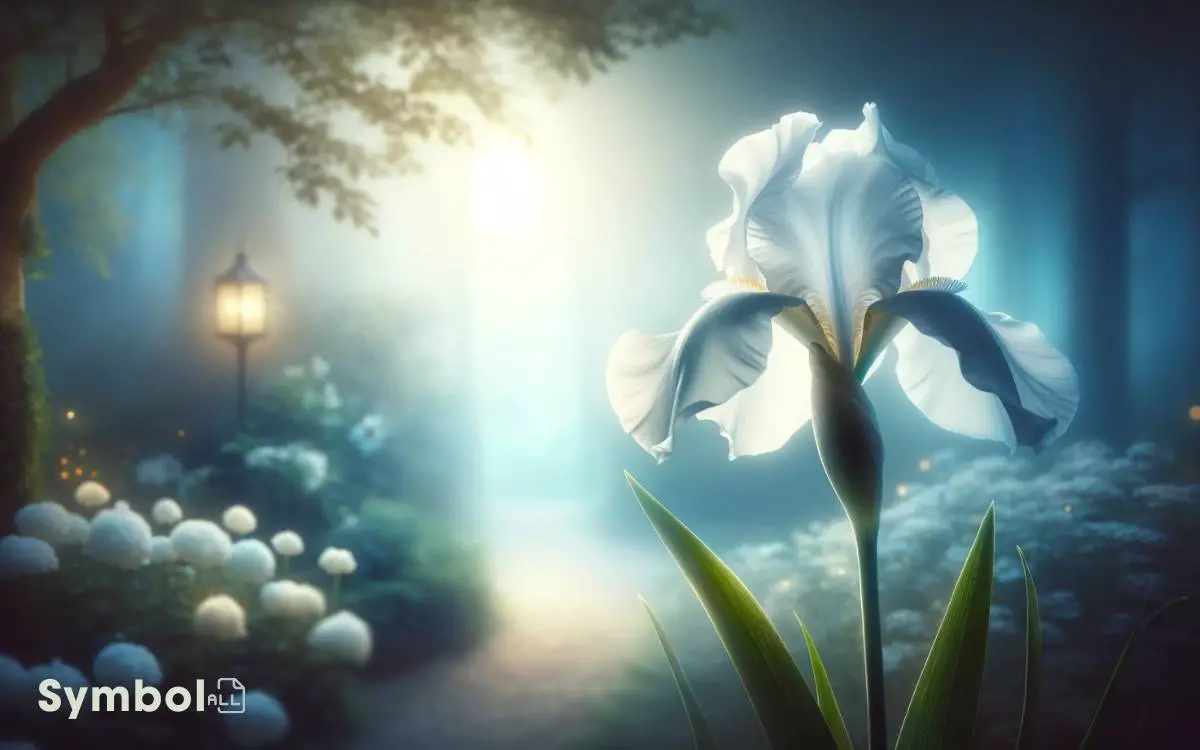What Flower Symbolizes Faith in God? White Lily!
The lily symbolizes your faith in God, showcasing unblemished petals that imply spiritual purity. This flower embodies a connection between the earthly and the divine, with its growth from muddy waters reflecting rebirth and enlightenment.
Its historical reverence, seen in ancient civilizations and intertwined with the Virgin Mary in Medieval Christianity, highlights its profound spiritual significance.
Across various cultures, the lily represents purity, rebirth, and motherhood, tying back to its role as a symbol of faith.
Perceived universally, its presence in religious texts and artifacts extends beyond mere decoration, suggesting a deeper exploration will reveal even more about its enduring significance.

Key Takeaways
The Symbolic Flower Revealed
The white lily, often regarded as the quintessential symbol of purity and devotion, embodies faith in God across various cultures and religions. Its elegant form and unblemished petals serve as a visual confirmation for spiritual purity and the soul’s unyielding devotion to the divine.
You’ll find that its presence in religious texts and artifacts isn’t merely decorative; it’s deeply emblematic, signifying a bridge between the earthly and the divine.
This connection is further enriched by the lily’s growth pattern, emerging from muddy waters to bloom unscathed, a powerful symbol of rebirth and enlightenment.
The white lily’s association with faith in God isn’t arbitrary but a demonstration of its enduring significance in conveying spiritual truths and guiding the faithful towards a deeper understanding of their beliefs.
Historical Origins and Significance
Delving into its historical origins, you’ll discover that the white lily’s significance as a symbol of faith in God is rooted in centuries of religious and cultural traditions. This emblem of purity and devotion has traversed through time, carrying with it a profound spiritual weight.
- Ancient Civilizations: The white lily was revered for its beauty and association with divinity, hinting at an innate human desire to connect with the divine.
- Medieval Christianity: It became intertwined with the Virgin Mary, symbolizing her purity and role as the mother of God, reinforcing its religious connotations.
- Literary References: Throughout literature, the white lily has been a metaphor for spiritual enlightenment and the pursuit of truth, emphasizing its enduring relevance.
Understanding the white lily’s historical context enriches your appreciation of its symbolic significance, bridging past beliefs with present values.
Spiritual Symbolism Across Cultures
While exploring the white lily’s role as a symbol of faith in God, it’s important to contemplate how its spiritual symbolism varies across different cultures.
The white lily holds a unique position in spiritual traditions worldwide, each attributing to it a specific set of meanings and values.
Here’s a concise table representing its symbolism across various cultures:
| Culture | Symbolism | Context |
|---|---|---|
| Christianity | Purity, Virgin Mary | Religious ceremonies, symbols of faith |
| Ancient Greece | Rebirth, Motherhood | Mythology, associated with Hera |
| Buddhism | Purity, Enlightenment | Spiritual practices, art |
| Chinese | 100 years of love, Good luck | Weddings, New Year celebrations |
| Egyptian | Fertility, Rebirth | Ancient rituals, art |
This table illustrates the rich tapestry of meanings the white lily embodies, showcasing its versatility as a spiritual symbol across diverse cultures.
Botanical Profile and Characteristics
Often overlooked, white lilies possess a complex botanical profile that reveals their adaptability and resilience across various climates. These characteristics make them a fitting symbol for faith in God, which similarly thrives in diverse conditions.
- Perennial Nature: White lilies return year after year, symbolizing the enduring nature of faith.
- Wide Climatic Tolerance: They can grow in a range of environments, from cold temperate to tropical, mirroring faith’s universality.
- Varied Blooming Times: Depending on the species, white lilies bloom at different times, representing the idea that faith can manifest in various stages of life.
Understanding these botanical traits enriches the appreciation of white lilies as symbols of faith, highlighting nature’s role in spiritual symbolism.
Biblical References and Interpretations
The Bible is replete with references to white lilies, symbolizing purity, resurrection, and the unwavering faith in God’s promise. Scholars often point to the Song of Solomon and the Sermon on the Mount as key texts where these symbols emerge vividly.
In the Song of Solomon, the lily is associated with love and beauty, reflecting the purity and faithfulness of the relationship between God and His people.
Meanwhile, in the Sermon on the Mount, Jesus uses the lily to illustrate God’s providential care, encouraging believers to have faith and not worry about their needs.
These biblical passages underline the lily’s role as a symbol of trust in divine providence and the purity of faith unblemished by worldly concerns.
Faith Representations in Art and Literature
You’ll find that art and literature serve as profound vessels for faith’s expressions, weaving together symbols like biblical floral imagery, and interpretations that resonate deeply.
Literary faith symbols, for instance, encapsulate beliefs and values in narratives that have captivated audiences for centuries.
Meanwhile, artistic interpretations offer a visual dialogue on faith, inviting viewers into a space of contemplation and spiritual connection.
Biblical Floral Imagery
In biblical floral imagery, artists and writers have long employed flowers as symbols to represent faith in God, weaving these motifs into their works to convey deeper spiritual meanings.
This approach allows them to explore the nuanced relationship between the divine and the faithful, using the natural beauty and symbolism of flowers to express complex theological concepts.
- Lilies: Often associated with purity and the Virgin Mary, reflecting a trust in divine grace.
- Roses: Symbolize martyrdom and the blood of Christ, demonstrating ultimate faith and sacrifice.
- Olive Branch: Represents peace and reconciliation with God, highlighting the faith required to attain spiritual harmony.
Literary Faith Symbols
Moving beyond the canvas and the page, symbols of faith in literature and art often embody profound spiritual journeys and revelations.
You’ll find that authors and poets weave complex narratives where faith’s essence isn’t directly stated but represented through motifs and symbols.
For example, the journey in Dante’s ‘Divine Comedy’ symbolizes the soul’s path towards God, using vivid imagery and allegorical landscapes to explore themes of faith, redemption, and divine love.
Similarly, in more contemporary literature, characters may undergo trials that test their faith, with their resolutions offering deep insights into the human spirit’s resilience and capacity for belief.
These literary devices invite you to ponder the multifaceted nature of faith and its enduring presence in the human experience.
Artistic Interpretations
Artistic interpretations of faith, whether manifested in the brushstrokes of a painting or the prose of a novel, invite us to explore the profound and multifaceted ways humans understand and represent their spiritual beliefs.
These depictions aren’t merely aesthetic; they’re gateways to deeper comprehension and reflection.
- Renaissance Paintings: Artists like Michelangelo infused their works with religious symbolism, making faith a tangible experience through visual art.
- Literary Allegories: Novels such as ‘The Pilgrim’s Progress’ use narrative as a means to discuss and dissect the essence of faith and its trials.
- Modern Art Installations: Contemporary artists often employ abstract forms to represent faith, challenging viewers to interpret personal beliefs in a communal space.
Analyzing these artistic expressions enriches our understanding of faith’s complexity and its place in human culture.
Gardening Tips for the Faithful Bloom
Cultivating a garden that embodies faith necessitates understanding the specific requirements and symbolic significance of the faithful bloom.
You must select plants not only for their beauty but for their ability to thrive in your garden’s unique conditions.
Research is paramount; understanding soil pH, sunlight exposure, and watering needs secures your chosen flowers flourish, symbolizing your faith’s resilience and growth.
It’s also crucial to contemplate the bloom’s lifecycle annuals versus perennials to reflect ongoing faith or renewal.
Additionally, integrating these blooms into your garden’s design thoughtfully creates a space for reflection and meditation, enhancing the spiritual significance of your horticultural efforts.
Modern Day Relevance and Celebrations
In today’s rapidly evolving society, the flower symbolizing faith in God retains its profound significance, weaving through various modern celebrations and observances to underscore the timeless nature of spiritual belief.
This emblem of faith isn’t just a relic of the past but continues to be a vibrant part of contemporary spiritual expression.
- Easter and Christmas: Utilized in decorations and services to symbolize renewal and divine love.
- Weddings and Baptisms: Embodies promises of faithfulness and the beginning of spiritual journeys.
- Memorial Services: Offers comfort and signifies hope in eternal life.
These instances highlight the flower’s enduring relevance, demonstrating how traditional symbols can maintain their significance in modern contexts, enriching celebrations with layers of meaning that speak to the soul’s journey through faith.
Conclusion
In sum, the symbolic flower representing faith in God weaves a rich tapestry across cultures and history, blossoming with deep spiritual significance. Its roots, deep in tradition, reflect a universal yearning for divine connection.
As the adage goes, ‘Faith is the bird that feels the light and sings when the dawn is still dark.’
This flower, in its humble grace, embodies this sentiment, encouraging us to cultivate our gardens of belief with diligence and reverence, illuminating the enduring power of faith in our lives.






